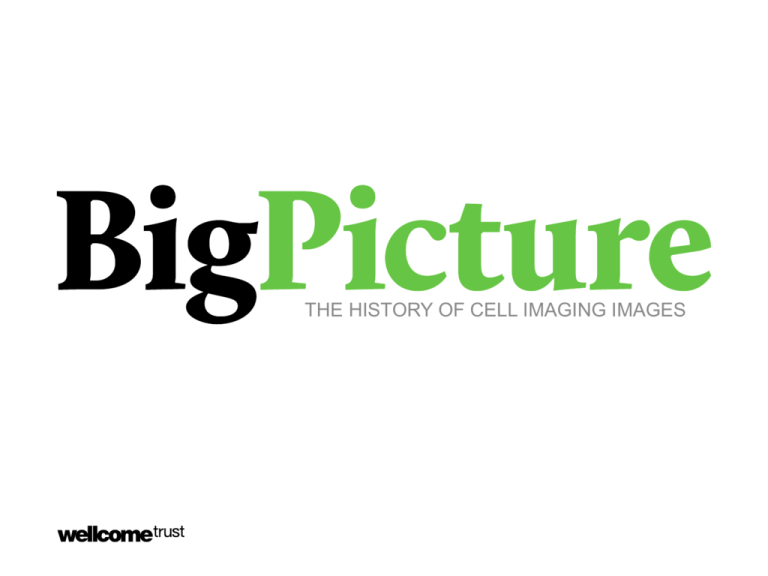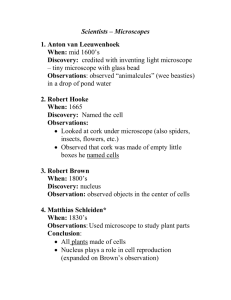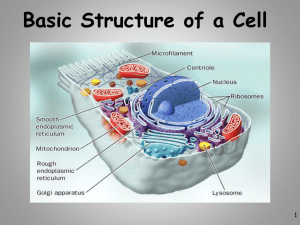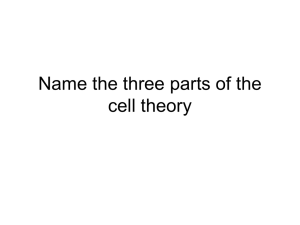Document
advertisement

THE HISTORY OF CELL IMAGING IMAGES Drawing of magnified cork A drawing of the magnified structure of cork from the book ‘Micrographia’, written by the brilliant polymath Robert Hooke, published in 1665. The book details Hooke’s observations using a variety of lenses, and uses the term ‘cell’ to describe the compartments seen in the cork’s structure. Although used in a different context today, the origin of the word comes from the book, which became the first scientific bestseller. BIGPICTUREEDUCATION.COM Antonie van Leeuwenhoek A painting produced c.1680 of Antonie van Leeuwenhoek. Van Leeuwenhoek was the first person to describe single-celled organisms, which he termed ‘animalcules’. Considered by many to be the first microbiologist, van Leeuwenhoek is remembered for his advancements to the early development of the microscope. The simple microscopes he developed consisted of a single lens mounted on a brass plate, with a screw to hold the sample in place. He kept secret his method for creating high-quality lenses - tiny glass spheres - which remains one of the most important technical advances in the history of science. Drawing of a sperm Nicolaas Hartsoeker was a student of Antonie van Leeuwenhoek who together were the first to observe sperm microscopically. Hartsoeker believed that tiny humans were present within the sperm cells, which he called homunculi. This image by Hartsoeker, published in 1694, shows a homunculus within a sperm. BIGPICTUREEDUCATION.COM Monster soup engraving The top of this 1828 etching reads, “MICROCOSM dedicated to the London Water Companies. Brought forth all monstrous, all prodigious things, hydras and organs, and chimeras dire.” The bottom caption reads “MONSTER SOUP commonly called THAMES WATER, being a correct representation of that precious stuff doled out to us!” The image depicts a woman dropping her teacup in horror after seeing a magnified view of a droplet of London water. During this time period the water supply was becoming increasingly polluted, with the first outbreak of cholera occurring in 1831. BIGPICTUREEDUCATION.COM Drawings of cellular tissue Mattias Jakob Schleiden published ‘Contributions to Phytogenesis’ in 1838, while Professor of Botany at the University of Jena. Schleiden used microscopy extensively in his study of plants and his book was the first to state that all plant organs were composed of cells. Over dinner in 1838, Schleiden was describing his work to friend Theodor Schwann, who was struck by the similarities seen with his own studies on animals. The work of the two men became the basis of ‘cell theory’, and applied universally to both plants and animals. BIGPICTUREEDUCATION.COM Drawings of cells Theodor Schwann was a master microscopist, and was the first to conclude that animals are composed of cells. His discoveries were published in 1839, a year after Matthias Jakob Schleiden suggested that plants are also made entirely of cells. The picture above is taken from his principal work, ‘Microscopic Investigations on the Accordance in the Structure and Growth of Plants and Animals’, in which he stated that “The elementary parts of all tissues are formed of cells.” The work of Schleiden and Schwann was the basis of ‘cell theory’, which described the cell as the basic unit of life. BIGPICTUREEDUCATION.COM Textbook image of blood cells The above image comes from the 1845 textbook ‘Cours de Microscopie Complementaire des Etudes Medicales’, by Alfred Donné. The pictures were taken using a photoelectric microscope, invented by Donné and his assistant Léon Foucault. This technology was developed to enable the projection of microscopic images onto a wall during Donné’s lectures on microscopy. Early photographic methods allowed Donné to capture the images for his textbook. Despite the innovative nature of the book, it failed to sell, as the use of microscopes in medical diagnoses was limited. In modern terms, a photoelectric microscope is one which uses electron emission to generate image contrast. BIGPICTUREEDUCATION.COM Drawing of a ramified nerve cell This picture shows a ramified nerve cell, drawn by Albert von Kölliker in 1852. Kölliker was a pioneer of histology, the microscopic study of cells and tissues. He is chiefly remembered for his work on the nervous system that showed that neurons are continuous with nerve fibres, forming the basis of the idea of a central nervous system. BIGPICTUREEDUCATION.COM Joseph Jackson Lister Joseph Jackson Lister, seen here c.1860, was the inventor of the achromatic lens, a major technical breakthrough in microscope technology. Chromatic aberration is caused when a lens is unable to focus all the separate coloured wavelengths that make up visible light into the same place. This distortion meant that objects viewed down early microscopes had coloured ‘fringes’ that were not really there. This was a serious problem, but Lister’s development of this new lens meant that the microscope had finally become a reliable tool for research. Lister’s son, the surgeon Joseph Lister, was one of the earliest to promote the idea of aseptic surgery. He introduced the use of carbolic acid (phenol) to sterilise equipment and wounds, drastically reducing the risks of post-operative infections. BIGPICTUREEDUCATION.COM Louis Pasteur The traditional view of disease up until to the mid-19th century was that of ‘spontaneous generation’ - in which life, and disease, were created from inanimate matter, such as maggots spontaneously developing from rotting flesh. Louis Pasteur, a French microbiologist and chemist, was one of the founders of the ‘germ theory’ of disease. His groundbreaking experiment involved the boiling of flasks of nutrient broth in swan-necked flasks, which prevented any dust or contaminants entering the broth. The contents of the flask remained sterile unless they were opened and exposed to air, proving that the microbes contaminating the broth came from outside rather than spontaneously generating within the flask. BIGPICTUREEDUCATION.COM Drawing of cells infected with leprosy bacilli The disease leprosy has been documented for thousands of years. It was thought of as an inherited disease until the causative agent, Mycobacterium leprae, was discovered in 1873 by the Norwegian physician Gerhard Armauer Hansen. Although Hansen showed that M. leprae was present in the tissues of all leprosy sufferers, he was unable to identify it as a bacterium. This was done by Albert Neisser in 1880. Leprosy is sometimes known as Hansen’s disease after its discoverer. The above illustration by Hansen, published in 1895, shows cells infected with M. leprae. BIGPICTUREEDUCATION.COM Diagrams from a lecture by Paul Ehrlich The German scientist Paul Ehrlich was a pioneer in the fields of immunology and chemotherapy. Before the discovery of antibiotics, Ehrlich was interested in finding so-called ‘magic bullets’, chemical toxins that have affinity for a specific disease. Ehrlich and his colleagues tested hundreds of chemicals against a multitude of diseases. One of his discoveries was the drug Salvarsan, at the time a hugely effective treatment for syphilis. The above diagram is from Ehrlich’s 1900 lecture, where he described his ‘side-chain’ theory of the immune system, much of which was verified with the use of modern molecular techniques. BIGPICTUREEDUCATION.COM Drawings of vaginal cells In 1923 Georgios Papanikolaou, a Greek pathologist, told a group of physicians about a non-invasive method he had developed for the early detection of cervical cancer. This test is now commonly known as a Pap smear. By examining cervical cells under a microscope, Papanikolaou was able to easily identify cancerous and precancerous cells. While his ideas were met with initial scepticism, the technique he developed has undoubtedly saved millions of lives. The above image, published in 1933, shows a selection of cells found in a normal human vaginal smear. This technique is an example of cytopathology, the diagnosis of disease at a cellular level. BIGPICTUREEDUCATION.COM Scanning electron micrograph of an inner ear hair cell Light microscopes are normally capable of magnification of approximately x1,000. Above this level the ability of the microscope to distinguish between two closely spaced objects, known as resolving power, becomes limited by the wavelength of light. Electrons have a wavelength 100,000 times shorter than visible light, which allows useful magnification up to x2,000,000. The first practical electron microscope was built in the University of Toronto in 1938, with the first commercially available model built in 1939. There are two main types of electron microscope: the transmission electron microscope (TEM), which fires electrons through a thin slice of sample to a receiver, and the scanning electron microscope (SEM), which detects electrons bounced back from a 3D structure. The image above, taken using SEM, depicts the sensory hair bundle of a single hair cell from a terrapin’s inner ear. One of the disadvantages of electron microscopy is that all images are black and white, and computer software is needed to give them colour. Credit: Dr David Furness, Wellcome Images. BIGPICTUREEDUCATION.COM Reusing our images Images and illustrations • All images, unless otherwise indicated, are from Wellcome Images. • Contemporary images are free to use for educational purposes (they have a Creative Commons Attribution, Non-commercial, No derivatives licence). Please make sure you credit them as we have done on the site; the format is ‘Creator’s name, Wellcome Images’. • Historical images have a Creative Commons Attribution 4.0 licence: they’re free to use in any way as long as they’re credited to ‘Wellcome Library, London’. • Flickr images that we have used have a Creative Commons Attribution 4.0 licence, meaning we – and you – are free to use in any way as long as the original owner is credited. • Cartoon illustrations are © Glen McBeth. We commission Glen to produce these illustrations for ‘Big Picture’. He is happy for teachers and students to use his illustrations in a classroom setting, but for other uses, permission must be sought. • We source other images from photo libraries such as Science Photo Library, Corbis and iStock and will acknowledge in an image’s credit if this is the case. We do not hold the rights to these images, so if you would like to reproduce them, you will need to contact the photo library directly. • If you’re unsure about whether you can use or republish a piece of content, just get in touch with us at bigpicture@wellcome.ac.uk.







